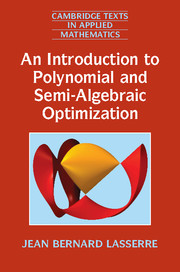Book contents
- Frontmatter
- Dedication
- Contents
- Preface
- List of symbols
- 1 Introduction and message of the book
- PART I POSITIVE POLYNOMIALS AND MOMENT PROBLEMS
- PART II POLYNOMIAL AND SEMI-ALGEBRAIC OPTIMIZATION
- PART III Specializations and extensions
- 13 Convexity in polynomial optimization
- 14 Parametric optimization
- 15 Convex underestimators of polynomials
- 16 Inverse polynomial optimization
- 17 Approximation of sets defined with quantifiers
- 18 Level sets and a generalization of the Löwner–John problem
- Appendix A Semidefinite programming
- Appendix B The GloptiPoly software
- References
- Index
17 - Approximation of sets defined with quantifiers
Published online by Cambridge University Press: 05 February 2015
- Frontmatter
- Dedication
- Contents
- Preface
- List of symbols
- 1 Introduction and message of the book
- PART I POSITIVE POLYNOMIALS AND MOMENT PROBLEMS
- PART II POLYNOMIAL AND SEMI-ALGEBRAIC OPTIMIZATION
- PART III Specializations and extensions
- 13 Convexity in polynomial optimization
- 14 Parametric optimization
- 15 Convex underestimators of polynomials
- 16 Inverse polynomial optimization
- 17 Approximation of sets defined with quantifiers
- 18 Level sets and a generalization of the Löwner–John problem
- Appendix A Semidefinite programming
- Appendix B The GloptiPoly software
- References
- Index
Summary
Introduction
In many applications of interest one has to handle a class of sets R ⊂ ℝn whose definition contains a set K ⊂ ℝn+p and some quantifier ∃ or ∀. In other words, R is described with the help of additional variables y ∈ ℝp and constraints linking x ∈ ℝn and y ∈ ℝp. To obtain an exact explicit description of R ⊂ ℝn solely in terms of the x-variables is a difficult and challenging problem in general. If K ⊂ ℝn+p is semi-algebraic then it is certainly possible and this is part of Elimination Theory in Algebraic Geometry. Most of the associate dalgorithms are based on Gröbner basis methods (with exact arithmetic) and in practice quantifier elimination is very costly and is limited to small size problems or particular cases.
The goal of this chapter is less ambitious as we only want to obtain approximations of R with some convergence properties. We provide a nested sequence of outer (respectively inner) approximations Rk, k ∈ ℕ, such that the Lebesgue volume of Rk converges to that of R as k → ∞. Moreover the outer (respectively inner) approximations Rk are of the form {x ∈ ℝn : pk(x) ≤ 0} for some polynomial pk, k ∈ ℕ, of increasing degree. Therefore approximations (possibly crude if k is small) can be obtained for cases where exact elimination is out of reach.
Problem statement
Consider two sets of variables x ∈ ℝn and y ∈ ℝm coupled with a constraint (x, y) ∈ K, where K is the basic semi-algebraic set:
K ≔ {(x, y) ∈ ℝn × ℝm : x ∈ B; gj (x, y) ≥ 0, j = 1, …, s}
for some polynomials gj, j = 1, …, s, and B ⊂ ℝn is a simple set (e.g. some box or ellipsoid).
- Type
- Chapter
- Information
- An Introduction to Polynomial and Semi-Algebraic Optimization , pp. 272 - 285Publisher: Cambridge University PressPrint publication year: 2015



